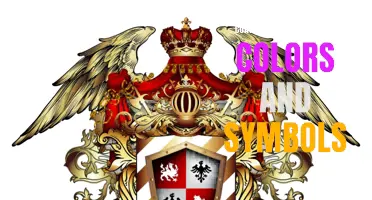
Ganesha, also known as Ganapati or Vinayaka, is one of the most widely worshipped deities in the Hindu pantheon. With the head of an elephant and the body of a human, Ganesha is instantly recognized by his unique appearance. But beyond his physical form, Ganesha's symbolism carries a deep and profound meaning. From remover of obstacles to the embodiment of wisdom and intelligence, Ganesha represents various qualities and virtues that hold great significance in Hindu culture and beyond. Join me as we explore the fascinating symbolisms behind this beloved deity and uncover the wisdom and lessons that Ganesha imparts.
What You'll Learn
- What is the meaning behind the Ganesh symbol in Hinduism?
- How is the Ganesh symbol represented in art and sculptures?
- What are the different elements and symbols associated with Ganesh?
- How does the Ganesh symbol tie into the concept of overcoming obstacles?
- Are there any specific rituals or practices related to the Ganesh symbol and its meaning?

What is the meaning behind the Ganesh symbol in Hinduism?
Ganesh is one of the most beloved and widely worshiped deities in Hinduism. The elephant-headed god is known as the remover of obstacles and the god of wisdom, intellect, and new beginnings. His symbol, the Ganesh symbol, holds significant meaning in Hinduism. Let's explore the meaning and symbolism behind the Ganesh symbol.
The Ganesh symbol, also known as the Ganesh Yantra or Ganesh Mandala, is a geometric representation of Lord Ganesh. It is a sacred symbol used in Hindu rituals and is believed to embody Ganesh's protective and auspicious energy. The symbol is made up of multiple elements that collectively represent Ganesh's qualities and attributes.
At the center of the Ganesh symbol is the figure of Ganesh himself. He is depicted with an elephant's head, a large stomach, and four arms. The elephant head symbolizes wisdom, strength, and dominance, while the large stomach represents his ability to consume various experiences and emotions of life and transform them into positive energy. His four arms symbolize his ability to multitask and accomplish multiple tasks simultaneously.
Surrounding Ganesh's figure are various geometric shapes and symbols, each with its own significance. These include a lotus flower, which represents purity and spiritual enlightenment; a trident, which represents the three aspects of existence - creation, preservation, and destruction; and an Om symbol, which represents the essence of the universe and the divine presence.
The Ganesh symbol is often used in Hindu rituals and ceremonies to seek Ganesh's blessings and remove obstacles from one's path. It is believed that by meditating on or wearing the Ganesh symbol, one can invoke Ganesh's energy and overcome obstacles that hinder personal and spiritual growth.
Apart from its spiritual significance, the Ganesh symbol also holds a practical meaning. In Hindu culture, Ganesh is considered the patron deity of all endeavors and is invoked at the beginning of any important task or endeavor. The Ganesh symbol is often used as a reminder to seek Ganesh's blessings and guidance before embarking on a new project or endeavor.
The Ganesh symbol is also associated with the concept of "Ganesh Chaturthi," a Hindu festival dedicated to Lord Ganesh. During this festival, people create clay statues of Ganesh and worship them for several days before immersing them in water. The Ganesh symbol is often used as a representation of Lord Ganesh during this festival.
In conclusion, the Ganesh symbol in Hinduism holds deep meaning and symbolism. It represents Lord Ganesh, the revered deity known for removing obstacles and granting wisdom. The symbol's various elements, such as the lotus flower, trident, and Om symbol, represent different aspects of Ganesh's qualities and attributes. By invoking the energy of the Ganesh symbol, individuals can seek blessings and remove obstacles from their path. Whether used in rituals, ceremonies, or as a reminder before embarking on new endeavors, the Ganesh symbol remains a powerful and sacred representation of Lord Ganesh's energy and presence.
Understanding the Meaning of Oven Dial Symbols: A Comprehensive Guide
You may want to see also

How is the Ganesh symbol represented in art and sculptures?
In Hindu culture, Lord Ganesh is one of the most worshipped deities. He is the god of wisdom, intelligence, and prosperity, and is often referred to as the Remover of Obstacles. Ganesh is easily recognizable by his distinct physical attributes, especially his elephant head. This unique appearance has been depicted in various forms of art and sculptures throughout history.
The Ganesh symbol is commonly represented in both paintings and sculptures. In paintings, Ganesh is often depicted with a round, red body, multiple arms, and a serene expression on his face. His large elephant head is proportioned with a small human body, symbolizing his wisdom and power. He is usually portrayed sitting on a lotus flower, symbolizing purity and spirituality. The paintings often incorporate vibrant colors and intricate details to emphasize the divine nature of Lord Ganesh.
Sculptures of Ganesh are also prevalent in Hindu art. These sculptures can be found in temples, homes, and public places. The most common material for Ganesh sculptures is stone, although they can also be made from metal, wood, or clay. The sculptures vary in size and style, but they all feature Ganesh's elephant head, often decorated with a crown or a headdress. His multiple arms are depicted holding various symbolic objects, such as a lotus flower, a conch shell, a rope, or a bowl of sweets. These objects represent different aspects of his divine power and ability to grant blessings.
Another significant feature of Ganesh sculptures is his large, pot-bellied body. This represents his ability to consume all the sorrows and difficulties of his devotees, leaving them with a sense of peace and tranquility. The sculptures often have a joyful and playful expression, reflecting Ganesh's playful nature and his role as a bringer of happiness and good fortune.
Ganesh sculptures are also adorned with intricate patterns and designs. These include geometric shapes, floral motifs, and elaborate clothing. The jewelry and ornaments worn by Ganesh symbolize his status as a divine being and a deity of wealth and prosperity.
In addition to paintings and sculptures, the Ganesh symbol can also be found in other forms of art, such as murals, tapestries, and jewelry. His image is widely revered and is considered auspicious, so it is often incorporated into various aspects of daily life and religious ceremonies.
Overall, the representation of the Ganesh symbol in art and sculptures is a reflection of the admiration and devotion towards Lord Ganesh in Hindu culture. The distinct physical attributes of Ganesh, such as his elephant head and multiple arms, are depicted with immense detail and artistic creativity. These representations serve as a reminder of Ganesh's wisdom, power, and ability to overcome obstacles in life. The art and sculptures not only capture the essence of Lord Ganesh but also inspire and uplift the spirits of his devotees.
Exploring the Rich Symbolic Meaning Behind the 6-Pointed Star
You may want to see also

What are the different elements and symbols associated with Ganesh?
Ganesh, also known as Ganesha or Ganapati, is one of the most widely worshipped deities in Hinduism. He is revered as the remover of obstacles, the patron of arts and sciences, and the god of intellect and wisdom. Ganesh is depicted with various elements and symbols that represent his different attributes and characteristics. In this article, we will explore the different elements and symbols associated with Ganesh.
- Elephant Head: The most distinctive feature of Ganesh is his elephant head. According to Hindu mythology, Ganesh was created by his mother, Goddess Parvati, who shaped him out of clay and breathed life into him. However, when Lord Shiva, Parvati's husband, beheaded Ganesh during a misunderstanding, he replaced his head with that of an elephant. The elephant head symbolizes wisdom, intelligence, and memory.
- Big Belly: Ganesh is often depicted with a big belly, which symbolizes his ability to digest all the experiences of life, both good and bad. It represents his capacity to accept everything with equanimity and stay detached from worldly desires and attachments. The big belly also signifies the abundance and prosperity that he bestows upon his devotees.
- Four Arms: Ganesh is typically depicted with four arms, each holding a different object. The four arms symbolize his omnipresence and his ability to perform multiple tasks simultaneously. They also represent the four universal virtues: righteousness, wealth, desire, and liberation.
- Broken Tusk: One of Ganesh's tusks is often depicted as broken. There are different stories behind this broken tusk. One popular legend is that Ganesh broke his own tusk to use it as a writing instrument when he was dictating the epic Mahabharata to the sage Vyasa. The broken tusk represents sacrifice, selflessness, and the willingness to give up something valuable for the benefit of others.
- Modak: Ganesh is known to be fond of sweets, especially modak, a traditional Indian sweet dumpling. The modak symbolizes the rewards of devotion and the sweetness of achieving spiritual goals. It represents the joy and fulfillment that come from dedicating oneself to the path of righteousness and seeking the divine.
- Mouse: Ganesh is often accompanied by a mouse, which serves as his vehicle or mount. The mouse represents the ego, desires, and attachment to worldly pleasures. By sitting on the mouse, Ganesh signifies his control over these aspects of life and teaches his devotees to overcome their ego and desires.
- Lotus: Ganesh is often depicted sitting on or holding a lotus flower. The lotus symbolizes purity, enlightenment, and spiritual awakening. It represents the divine consciousness that Ganesh embodies and signifies his ability to rise above the material world and connect with the higher realms.
These are just a few of the many elements and symbols associated with Ganesh. Each symbol carries deep meaning and significance, and they collectively represent the various aspects of Ganesh's personality and teachings. Worshipping Ganesh and connecting with these symbols can help his devotees overcome obstacles, gain wisdom, and find inner peace and prosperity in their lives.
Demystifying the Airbag Symbol: What Does it Mean and Why is it Important?
You may want to see also

How does the Ganesh symbol tie into the concept of overcoming obstacles?
The Ganesh symbol holds great significance in Hinduism and is closely associated with the concept of overcoming obstacles. Ganesh, also known as Ganesha or Vinayaka, is one of the most widely worshiped deities in the Hindu pantheon. He is often depicted as a human-like figure with the head of an elephant and a portly body. He is known as the remover of obstacles and is believed to bring good fortune and success to those who worship him.
The symbolism of Ganesh as the remover of obstacles is deeply rooted in Hindu mythology and stories. According to one popular myth, Ganesh was created by the goddess Parvati, who formed him out of clay and brought him to life. She asked him to stand guard at the entrance of her bathing chamber and not let anyone enter. When Lord Shiva, Parvati's husband, tried to enter the chamber and was stopped by Ganesh, he became enraged and severed Ganesh's head. Parvati was devastated and demanded that Shiva bring her son back to life. Shiva, remorseful for his actions, replaced Ganesh's head with that of an elephant and granted him the boon of being worshiped before all other gods.
This myth highlights the importance of Ganesh as a guardian and protector. He is believed to be the gatekeeper of success and prosperity, and his presence can help remove any obstacles that may hinder an individual's path. Devotees often invoke Ganesh's blessings before beginning any important task or undertaking, seeking his help in removing any hurdles that may come their way.
The symbolism of the elephant head also plays a significant role in Ganesh's association with overcoming obstacles. Elephants are known for their strength, intelligence, and gentle nature. In Hinduism, they are seen as sacred animals and are believed to possess divine qualities. The elephant head represents Ganesh's wisdom and ability to discern between right and wrong. His wisdom allows him to not only identify obstacles but also find creative solutions to overcome them.
In addition to being the remover of obstacles, Ganesh is also considered the lord of beginnings and the patron of arts and sciences. His portrayal with four arms holding various objects symbolizes his ability to multitask and accomplish multiple things simultaneously. This aspect of Ganesh is often associated with success and prosperity in various aspects of life.
The worship of Ganesh is a common practice in Hindu households and temples. Individuals often seek his blessings and guidance when faced with challenges or striving to achieve their goals. Ganesh Chaturthi, a popular festival dedicated to Ganesh, is celebrated with great enthusiasm and involves the installation of Ganesh idols in homes and public places. The festival lasts for ten days and culminates with the immersion of the idols in water, symbolizing the return of Ganesh to his abode after granting the devotees' wishes.
In conclusion, the Ganesh symbol is strongly tied to the concept of overcoming obstacles in Hinduism. Ganesh, with his elephant head and unique attributes, symbolizes the wisdom, strength, and intellect needed to face and overcome challenges. The worship of Ganesh is believed to bring good fortune and success, making him the go-to deity for those seeking to overcome obstacles in their lives.
Decoding the Mazda 3 Dashboard: Unraveling the Symbols and Meanings
You may want to see also

Are there any specific rituals or practices related to the Ganesh symbol and its meaning?
Ganesh, also known as Ganapati or Vinayaka, is one of the most widely worshipped deities in Hinduism. As the god of wisdom, success, and good fortune, his symbol holds great significance in Hindu culture and is often associated with rituals and practices.
The Ganesh symbol, also called the Ganesh yantra or Ganesh mandala, is a geometric representation of Lord Ganesh. It is a sacred emblem that is believed to embody the essence of the deity and is used for various purposes, including worship and meditation.
One of the most common rituals related to the Ganesh symbol is the Ganesh Chaturthi festival. This festival, celebrated in the Hindu month of Bhadrapada (August-September), involves the installation of Ganesh idols and fervent worship over a period of several days. During the festival, devotees create and decorate intricate Ganesh symbols, often made of clay or metal, and use them in puja (religious worship) ceremonies. These rituals are performed to invoke the blessings of Lord Ganesh and seek his guidance and assistance in overcoming obstacles and achieving success.
Another significant practice related to the Ganesh symbol is the chanting of the Ganesh mantra. The Ganesh mantra, "Om Gam Ganapataye Namaha," is a powerful invocation that is believed to help remove obstacles and bring good fortune. Devotees often recite this mantra while meditating on the Ganesh symbol, as a way to connect with the energy and qualities of Lord Ganesh.
In addition to these rituals and practices, the Ganesh symbol is often used as a talisman or amulet for protection and blessings. Many people wear or carry a small Ganesh symbol, such as a pendant or locket, as a reminder of the deity's presence and as a source of support and positivity in their lives.
Overall, the Ganesh symbol holds great importance in Hindu culture and is associated with a variety of rituals and practices. From elaborate ceremonies during festivals to daily meditation and recitation of mantras, devotees use the symbol to connect with the energy of Lord Ganesh and seek his blessings for success, wisdom, and good fortune in their lives.
Decoding the Symbolism Behind the Pontiac Logo
You may want to see also
Frequently asked questions
The Ganesh symbol, also known as the Ganesh Yantra, represents Lord Ganesh, one of the most revered deities in Hinduism. He is known as the remover of obstacles and the lord of beginnings. The Ganesh symbol is used as a way to connect with Lord Ganesh's energy and seek his blessings for success, prosperity, and removal of obstacles in life.
Lord Ganesh is depicted with an elephant head in the Ganesh symbol due to a popular mythological story. According to the Hindu scriptures, Lord Shiva, the supreme god, cut off his son Ganesh's head in a fit of anger. To appease Lord Shiva, a new head had to be found for Ganesh, and it was decided that the head of the first living being to be seen would be used. The first being was an elephant, hence Lord Ganesh is depicted with an elephant head. The elephant head symbolizes wisdom, strength, and grace.
Yes, the Ganesh symbol is often associated with the mantra "Om Gam Ganapataye Namaha." This mantra is a sacred chant dedicated to Lord Ganesh and is used to invoke his blessings and seek his protection. Chanting this mantra while meditating or while focusing on the Ganesh symbol is believed to bring good fortune, wisdom, and success.
The Ganesh symbol can be used by anyone, regardless of their religious or spiritual beliefs. Lord Ganesh is revered by people of various faiths, and his energy is believed to be universal. The Ganesh symbol is a powerful tool for seeking blessings and guidance, and anyone can connect with Lord Ganesh's energy through it.
There are various ways to incorporate the Ganesh symbol into your daily life. You can wear jewelry or clothing with the Ganesh symbol, place a Ganesh symbol in your home or workspace, or even use a Ganesh symbol as a screensaver on your electronic devices. Additionally, you can meditate or chant the Ganesh mantra while focusing on the symbol to invite Lord Ganesh's presence and blessings into your life.







